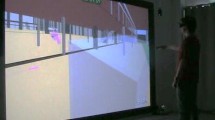Abstract
When sharing virtual collaborative environments, operators exchange spatial statements that refer to the objects’ positions in the virtual space. If operators are to understand each other, they need to develop a common spatial frame of reference and then choose a space coding to describe the objects’ positions. In this paper, we consider how the content of a virtual environment can influence communication between users. We designed two studies in which one participant (the speaker) had to indicate the position of one object to another participant (the addressee). The virtual environment was sometimes enriched by additional (proximal and distal) visual cues. In study 1, we considered statements production. We observed that the speakers most often used the avatar of their partner as a spatial reference to indicate a localization in the virtual space (i.e., Addressee-Centered coding) despite it increases their mental workload. Nevertheless, in complex situations, they also used distal cues to speak to the addressees (i.e., Exocentric coding of the space). In study 2, we considered statements comprehension. Addressee-Centered coding and Exocentric coding were used by the speakers in various spatial configurations to indicate the object position. We observed that Exocentric coding is the most difficult to manage for the addressee. These results indicate that speakers implemented the principle of less collaborative effort by adopting a way of exchanging information based on an asymmetrical cognitive cost, taking into consideration each other’s difficulties. This allows a balanced mental workload to be maintained between the two operators throughout the task.












Similar content being viewed by others
References
Bryant DJ, Tversky B (1999) Mental representations of spatial relations from diagrams and models. J Exp Psychol Learn Mem Cogn 25:137–156
Bryant DJ, Wright WG (1999) How body asymmetries determine accessibility in spatial frameworks. Q J Exp Psychol A 52(2):487–508
Cegarra J, Morgado N (2009) Étude des propriétés de la version francophone du NASA-TLX. In: Cahour B, Anceaux F, Giboin A (eds) EPIQUE 2009: 5ème Colloque de Psychologie Ergonomique. Nice, France, pp 233–239
Chellali A, Milleville-Pennel I, Dumas C (2013) Influence of contextual objects on spatial interactions and viewpoints sharing in virtual environments. Virtual Real J 17(1):1–15
Clark HH, Brennan SE (1991) Grounding in communication. In: Resnick LB, Levine J, Teasley SD (eds) Perspectives on socially shared cognition. APA, Washington D.C, pp 127–149
Clark HH, Wilkes-Gibbs D (1986) Referring as a collaborative process. Cognition 22(1):1–39
Duran ND, Dale R, Kreuz RJ (2011) Listeners invest in an assumed other’s perspective despite cognitive cost. Cognition 121:22–40
Duran N, Dale R, Galati A (2016) Toward integrative dynamic models for adaptive perspective taking. Top Cognit Sci 8:761–779
Galati A, Avraamides MN (2015) Social and representational cues jointly influence spatial perspective-taking. Cognit Sci 39:739–765. https://doi.org/10.1111/cogs.12173
Gaver WW, Sellen A, Heath C, Luff P (1993) One is not enough: multiple views in a media space. In: Proceedings of INTERCHI, pp 335–341
Hegarty M, Richardson AE, Montello DR, Lovelace K, Subbiah I (2002) Development of a self-report measure of environmental spatial ability. Intelligence 30:425–447
Heldal I, Tromp J (2006) The usability of collaborative virtual environments and methods for the analysis of interaction. Presence J Teleoper Virtual Environ 15(6):655–667
Heldal I, Spante M, Steed A, Bengstoon S (2005) Successes and failures in co-present situations. Presence J Teleoper Virtual Environ 14(5):563–579
Hindmarsh J, Fraser M, Heath C, Benford S, Greenhalg C (1998) Fragmented interaction: establishing mutual orientation in virtual environments. In: CSCW’98, pp 217–226
Hoc JM (2001) Towards a cognitive approach to human–machine cooperation in dynamic situations. Int J Hum Comput Stud 54:509–540. https://doi.org/10.1006/ijhc.2000.0454
McNamara TP (2003) How are the locations of objects in the environment represented in memory? In: Freksa C, Brauer W, Habel C, Wender KF (eds) Spatial cognition III. Spatial cognition 2002. Lecture notes in computer science (Lecture notes in artificial intelligence), vol 2685. Springer, Berlin
Michelon P, Zacks JM (2006) Two kinds of visual perspective taking. Percept Psychophys 68:327–337
Mou W, McNamara TP, Rump B, Xiao C (2006) Roles of egocentric and allocentric spatial representations in locomotion and reorientation. J Exp Psychol Learn Mem Cogn 32:1274–1290
Pouliquen-Lardy L, Mars F, Guillaume F, Milleville-Pennel I (2015) Virtual collaboration: effect of spatial configuration on spatial statements production. Cognit Process 16:S337–S342
Pouliquen-Lardy L, Milleville-Pennel I, Guillaume F, Mars F (2016) Effect of role distribution on the common spatial frame of reference in a remote collaborative task. Virtual Real 20(4):213–220. https://doi.org/10.1007/s10055-016-0294-8
Spante M, Schroeder R, Axelsson A-S, Christie M (2004) How putting yourself into the other persons virtual shoes enhances collaboration. In: Proceeding of the 7th international workshop on presence, Valencia, Spain, pp 190–196
Tversky B, Hard BM (2009) Embodied and disembodied cognition: spatial perspective-taking. Cognition 110:124–129. https://doi.org/10.1016/j.cognition.2008.10.008
Vandenberg SG, Kuse AR (1978) Mental rotations, a group test of three-dimensional spatial visualization. Percept Mot Skills 47:599–601
Author information
Authors and Affiliations
Corresponding author
Additional information
Publisher's Note
Springer Nature remains neutral with regard to jurisdictional claims in published maps and institutional affiliations.
Rights and permissions
About this article
Cite this article
Milleville-Pennel, I., Mars, F. & Pouliquen-Lardy, L. Sharing spatial information in a virtual environment: How do visual cues and configuration influence spatial coding and mental workload?. Virtual Reality 24, 695–712 (2020). https://doi.org/10.1007/s10055-020-00430-0
Received:
Accepted:
Published:
Issue Date:
DOI: https://doi.org/10.1007/s10055-020-00430-0




